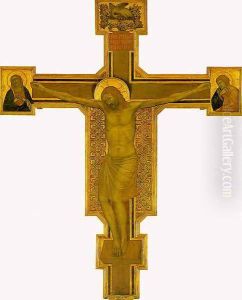Studio of Giotto Paintings
Giotto di Bondone, more commonly known as Giotto, was an Italian painter and architect from Florence during the Late Middle Ages. He is considered one of the foremost figures in Western art, credited with contributing significantly to the Renaissance by moving away from the stylized, Byzantine art style that dominated the era, and introducing more naturalistic representations of space and the human figure. Giotto's birth year is not precisely known, but it is often cited as around 1267. He passed away in 1337.
Giotto's early life is somewhat obscure, but it is believed that he was a pupil of the great Florentine painter Cimabue. Giotto's talent was recognized early on, and he quickly surpassed his master's abilities, setting the stage for a new era in the history of painting. Among his most significant works is the cycle of frescoes in the Scrovegni Chapel in Padua, completed around 1305, which is considered a masterpiece of the early Renaissance. The frescoes depict scenes from the life of the Virgin Mary and the life of Christ with an unprecedented emotional depth and realism.
Giotto was also an accomplished architect, having been appointed the chief architect of Florence Cathedral in 1334, where he designed the campanile (bell tower). His style influenced a generation of artists, and his workshop served as a training ground for many important painters of the time. The 'Studio of Giotto' refers to the collective body of work produced by Giotto and his workshop, which continued to operate even after his death, maintaining his stylistic approach and artistic principles.
The influence of Giotto's work on later artists cannot be overstated. He is often hailed as the father of European painting, and his methods laid the foundation for the Renaissance approach to art. His emphasis on capturing the human emotion and his exploration of perspective had a profound effect on the visual arts, leading to more life-like and emotionally engaging works that characterized the Renaissance period.
